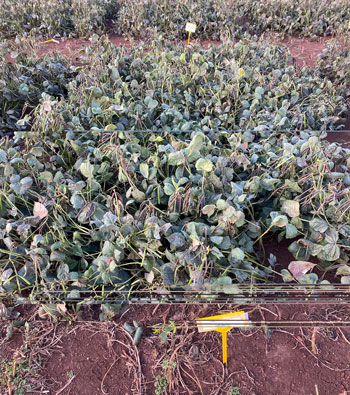Key points
- Preventive sprays against mungbean powdery mildew are not needed, research has shown
- Instead, the Powdery Mildew MBM app, a decision-support tool, could be used to guide spraying times
- Best management practice includes early sowing to avoid weather conditions favourable to the disease, and using the Powdery Mildew MBM app for decisions around fungicide applications
The common practice of preventively spraying for powdery mildew is not necessary, research by Professor Levente Kiss, the director of the University of Southern Queensland’s Centre for Crop Health, has found.
Professor Kiss and his team have tested this practice against recommendations by the Powdery Mildew MBM app, a decision-support tool released by the Department of Primary Industries and Regional Development (DPIRD) in 2019.
In southern Queensland in 2022 and 2023, the team managed small sections of growers’ paddocks according to the app’s recommendations. The rest of the crop was treated using the growers’ usual practices.
In half of the demonstration trials, the spray regimes were the same: growers’ practices coincided with the app’s recommendations.
However, in other paddocks, the app’s value quickly became evident, Professor Kiss says.
In these paddocks, both disease incidence and severity – and crop yield – were similar. This is despite sites treated according to the app’s recommendations always receiving less fungicide or none at all.
“Importantly, all demonstration trials show there is no value in preventive sprays – that is, spraying before the first sign of the disease.”
Figure 1: University of South Queensland Validation Expermiment 2023

This figure, one of the project’s most important, was made by compiling images taken by a drone. It shows the comparison between Tebuconazole and Veritas® Opti, applied as per growers’ practices versus the app’s recommendations. Source: Neil Robinson, University of Southern Queensland
Powdery mildew can cause up to 40 per cent yield losses in mungbean crops if it shows up before flowering, is left unsprayed, and environmental conditions are favourable to the disease. The disease might also impact harvest efficacy: desiccant uptake can be reduced if leaves and stems are heavily infected with powdery mildew.
Currently, there are few fungicides registered for the control of powdery mildew in mungbeans. Two products containing 430 g/L tebuconazole, mode of action Group 3 (demethylase inhibitor, DMI), are registered and other tebuconazole products can be used under permit PER13979.
The labels and permit say, for optimal disease control, apply at the first sign of disease. Veritas® Opti, which contains tebuconazole and azoxystrobin, the latter being mode of action Group 11 (quinone outside inhibitor, QoI), is registered for the control of powdery mildew in mungbeans. The Veritas Opti label says to apply at the first sign of disease or when conditions favour disease development.
Professor Kiss says industry practice often includes a preventive spray with either Tebuconazole or Veritas® Opti, before any sign of powdery mildew in the paddock.
“This is usually applied together with an insecticide and could be followed by a second spray at first sight of the disease; and a third spray approximately two weeks later, ‘just to be sure’.”
 Research has shown that most of the spray programs tested in experimental plot trials did not fully control powdery mildew infections, like this one, Professor Levente Kiss says. Source: Neil Robinson, University of Southern Queensland
Research has shown that most of the spray programs tested in experimental plot trials did not fully control powdery mildew infections, like this one, Professor Levente Kiss says. Source: Neil Robinson, University of Southern Queensland
Instead, the Powdery Mildew MBM app could make fungicide application decisions much more cost-effective.
The trials set out to test these practices against the app’s recommendations on preventive spraying, finding that preventive spraying was not worthwhile.
They also compared Tebuconazole and Veritas® Opti, applied as per growers’ practices versus the app’s recommendations (Figure 1).
However, unusually hot weather from January to March 2023 delayed disease emergence and conditions were not favourable to the disease until the last weeks of the growing season.
“Unfortunately, the validation trials could not capture the impact of powdery mildew on mungbean yields under different fungicide application regimes.
“However, other research has shown that most of the spray programs tested in experimental plot trials did not fully control powdery mildew infections (Figure 2).
With little genetic resistance in mungbean varieties, management mostly relies on fungicide sprays, so the findings are important.
Professor Kiss is also involved in a pilot project on fungicide resistance, led by the University of Southern Queensland’s Centre for Crop Health, and supported by the Broadacre Cropping Initiative (BACI), a partnership between the Queensland Department of Agriculture and Fisheries (DAF) and the university. It has detected the DNA markers of resistance to both tebuconazole and azoxystrobin in a few samples of mungbean powdery mildew collected in southern Queensland.
“This is a red flag and should be taken into consideration when sprays are planned as currently there are no other mode of action fungicides available for powdery mildew management in mungbeans.
“To manage the disease, and also fungicide resistance in the pathogens’ populations, the best option is to sow early in the season, try to avoid weather conditions that are favourable to the disease, and use the Powdery Mildew MBM app for decisions around fungicide applications.”
More information: Professor Levente Kiss
The Powdery Mildew MBM app is freely available for both Apple and Android devices in App Store and Play Store, respectively.
As a decision-support tool, the app helps guide fungicide application decisions and the likely economic returns from sprays on a paddock-by-paddock basis, depending on the observed disease levels, crop growth stage, expected yield and grain price, spray costs, weather forecast and estimated spraying efficacy.

























































